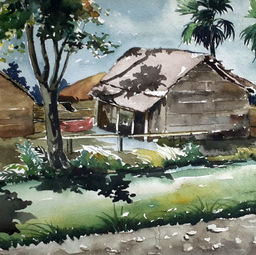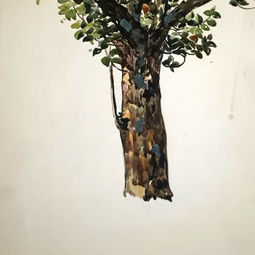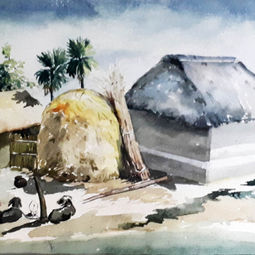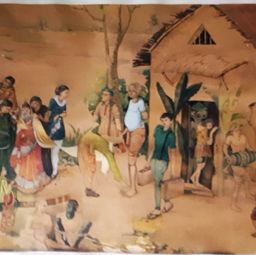Sanjay Singh Art
Kalakar Ji – A familiar-unfamiliar name

Kalar Ji receiving the President award from President A. P. J. Abdul Kalam
The journey of an artist known as ‘Kalakar Ji’, who travelled from a small village to the Rashtrapati Bhavan is very interesting. He lives in Purnea, Bihar,
Haveli Kharagpur of Munger district is known as the birthplace of ‘Mastermoshai’ Nandalal Bose, but there is another ‘Mastermoshai’ from the same place who is not known to many. His students may not have been able to become artists in the likes of Binod Bihari Mukherjee, Ram Kinkar Baij or K.G. Subramanyan, but this lesser-known artist has an important contribution in spreading art awareness among his students as well as grooming and shaping their character, personality and inspiring them to live a good life by showing them the right path. Comparing him with Mastermoshai Nandalal Bose means that just as he was always engaged in the progress of his students without thinking of his own career, Kalakar ji too always thought of his students first.
Born in 1939 in a small village called Khaira, which is situated amidst lush green mountains with a serpentine river flowing about two kilometres from Haveli Kharagpur, Munger. Shri Narendra Prasad Sinha had his basic education in his village and went to Haveli Kharagpur for higher education. From his student life, he was fond of painting, he had a special interest in sketching. In the geography class, when he had to draw, he used to complete his own work and then help his fellow students in sketching the same. Later, this interest took him to the art college. His love, inclination towards art was instinctive. It was his personal interest to pursue a career in it. But the journey from his village to the art college was not easy. After completing high school, he wanted to study fine art. A friend of his, who had been to Patna for some training, informed him about the Patna Art College. Then what!! he made up his mind, but as has often been the case with many artists, his family members were not happy with his decision and were not ready for it. Neither was it easy for his family to afford his studies in Patna. His elder brother took him to the headmaster of a nearby school to enquire about the future of studying fine art. Saddened by the negative comment from the headmaster, he came home and sat down disappointed and angry. One of his cousins, who was a teacher, saw this situation and resolved the matter. He spoke to the elders and got him permission to go ahead and seek admissions in the Art College and Narendra left for Patna.
The teachers at the Art College were surprised and impressed to see the drawings he made in the entrance examination and he was directly admitted to the second year. He completed his studies in 1960. Narendra had many options for earning a livelihood but he opted for teaching. He always wanted to pursue his career as a teacher. In 1961 he was appointed as an art teacher in Zila School Purnea. Upon joining the school, he made Purnea his home and stayed there permanently. Everyone in Purnea calls him Kalakar ji.
While he was teaching in Zila school, he met Shri Vishwanath Singh, another lesser-known artist of Purnea, who invited him for his exhibition of paintings at Kala Bhavan, Purnea. During that exhibition he met the founder of Kala Bhavan, Shri Lakshmi Narayan ‘Sudhanshu’ who was also the then speaker of the Bihar Legislative Assembly and Rashtrakavi Sri Ramdhari Singh ‘Dinkar’. During this interaction, there was discussion regarding art activities for children at Kala Bhavan. From then on art classes especially painting was started at Kala Bhavan, Purnea by Kalakar ji. Initially, it was an occasional event but Kalakar ji took over the responsibility of regular art classes on every Sunday. Gradually, many people joined these classes.
In a while, Shri Yogendra Mishra, an alumnus of Kala Bhavan, Santiniketan, joined him. Both thought of turning this hobby art class into an art college and put a lot of efforts in this direction. Everything was going on well. I was also a student of this art class. But after the demise of Sudhanshu ji the condition of Kala Bhavan deteriorated. The new management couldn’t do much to improve the situation, the teachers also gave up hopes and thus the dream of building an art college in Purnea remained incomplete. At Zila School, where Kalakar ji was teaching, art activities decreased due to negligence of the government and he had to teach subjects other than art. Not happy with this he took up a teaching job at Teacher Training Institute and shifted to Saharsa from Purnea. As a result, art classes at Kala Bhavan, Purnea closed. After retirement from the B.Ed. college in 1997, Kalakar ji returned to Purnea. He now lives and conducts art classes on Sundays from his residence in Purnea.
One of the qualities of Kalakar ji is that he gets immersed in whatever he does. While he was teaching at the Zila School, he was introduced to scouting. Out of curiosity, he took scouts training and got involved in it too. Since he liked to spend time with students it was a good opportunity to mingle with them. Once he started scouting, he continued it even in Saharsa where he was to teach in the B.Ed. College. Despite working in the B.Ed. college, he continued contributing to Scouting. As far as I am aware he was the only person who was both an artist and a scout master. Because of this, he was known for all kinds of artistic activities in the scout camp. In the national level scout gathering called Jamboree, he displayed his paintings along with his students and many a times created tableau. Once I myself went to Delhi with him to assist him in one such artistic endeavour. There he surprised everyone by creating a tableau of “Shaheed Smarak” a sculpture by Devi Prasad Roy Chowdhury. He painted seven students in silver paints and froze them in the same posture as that of the figures in the famous sculpture. It was a youth Congress convention and Kalakar ji was given the responsibility of making the tableau. The then Prime Minister Smt. Indira Gandhi was the chief guest at the event. There were lots of reviews regarding this tableau in Delhi newspapers. Similarly, in the Scouting Jamboree of Madras, he presented a tableau on behalf of Bihar. In this tableau, the life of Buddha was depicted through paintings and sculptures, which were highly appreciated. It was his unique effort to connect scouting and art for which he became known all over the country and was awarded the National Award for Scouting. He received the award from His Excellency the President of India, Shri Abdul Kalam at the Rashtrapati Bhavan.
Kalakar ji’s art practice is more of landscapes followed by narrative themes. His paintings show the same emotion, theme, and style as the artists of his time. The themes are mainly social, cultural such as weddings, fair, festivals, etc. Even though one can barely see any glimpse of modern or contemporary art in his paintings, the impression of the art of that era to which he belongs to is seen in his paintings. A glimpse of the surroundings can be clearly seen in these medium-sized landscape paintings. On seeing his paintings, one can easily read his simple personality. Artists generally have interest in various medium of art. He too was interested in sculpture as much as in painting both oil and water colour. But due to the low cost and quick completion, most of his paintings are in water colours. He made paintings on emotional, sentimental subjects but never exhibited his paintings independently. Whenever there was scope to exhibit, he displayed his paintings along with his students. He believes that this improves the enthusiasm of the students and gives the students a chance to learn. While evaluating/seeing his painting one must keep in mind the education system, knowledge, and awareness of that period.
Kalakar ji is not just a painter or scout teacher. He is also a social worker. He has served the society in many ways but never discuss about it. One such contribution of his needs to be mentioned. There were two brothers orphaned and living like servants in the house of one of their relatives. Kalakar ji heard that these young children make beautiful clay toys in their play time after taking care of the cattle of the house, he went and met them. Kalakar ji was very impressed to see the small statues made by one of the brothers. He thought of training them but the relative refused as he would lose the free labour. Seeing the pitiable condition of these children, he became emotional and after many efforts, he finally brought them to his own house and took care of them, admitted them to a school and also trained them in sculpture. Today, these two brothers are standing on their feet by making idols and are happy in their life. He never wanted anything in return for his efforts.
He did not get any kind of financial benefit from the art classes he conducted at Kala Bhavan, Purnea. His aim was to spread art. Even today, the art classes he conducts at his house are free of cost. He believes that no matter what profession a person adopts, if one has knowledge of art, they can live a successful, artistic and blissful life.
In a remote area like Purnea, where awareness about art is not among the common people, it was not an easy task to create a trend towards art, connect it with daily life and bringing children and youth towards it. Kalakar ji has an important contribution of introducing art to this city. Today, many of his students from Purnea went on to study art in various art institutions in the country and are practicing artists. Some of those who did not pursue art are also living a successful and artistic life by taking interest in art. In our country, there are many artists like Kalakar ji, are doing true service to art without any selfishness, and the art world needs to learn from them.
- Sanjay Singh.





